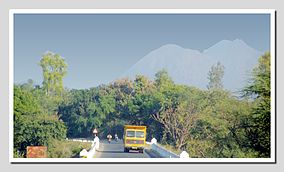Balaram Ambaji Wildlife Sanctuary
Wildlife sanctuary in India From Wikipedia, the free encyclopedia
Wildlife sanctuary in India From Wikipedia, the free encyclopedia
Seamless Wikipedia browsing. On steroids.
Every time you click a link to Wikipedia, Wiktionary or Wikiquote in your browser's search results, it will show the modern Wikiwand interface.
Wikiwand extension is a five stars, simple, with minimum permission required to keep your browsing private, safe and transparent.
Balaram Ambaji Wildlife Sanctuary is located at Banaskantha, Gujarat, India. It covers 542 km2, and falls in the catchment area of Banas and Sabarmati rivers,[1] and is a part of the Khathiar-Gir dry deciduous forests' ecoregion.[2] The sanctuary borders Rajasthan and close to mount abu. The period from October to May is considered to be the best time to visit.
| Balaram Ambaji Wildlife Sanctuary | |
|---|---|
IUCN category IV (habitat/species management area) | |
 View of peaks on the way to Ambaji in Sanctuary | |
 | |
| Location | Banaskantha District, Gujarat, India |
| Nearest city | Palanpur |
| Coordinates | 24.3561°N 72.6427°E |
| Area | 542.08 Km2 |
| Established | 7 August 1989 |
| Governing body | Gujarat Forest Department |
| gujaratforest | |
The sanctuary has 483 species of plants. 10 species are of lower plants, 40 of grass, 49 of climbers, 58 of shrubs, 107 of trees and 219 of herbs. Some of these, such as the Kadaya, have medicinal properties.[1]
Mammals found here are the sloth bear, striped hyena, Indian leopard, Nilgai (bluebull), Indian porcupine, Indian fox, small Indian civet and Indian pangolin. Reptiles found here are snakes (venomous and non-venomous), Indian star tortoises and monitor lizards.[1]
In 2016, a female sloth bear had attacked 8 people, including some forest officials, in Gujarat State's Banaskantha district, near the Sanctuary. 3 of the victims died, including an official who attempted to trace and cage it. The bear was eventually killed by a team of forest officials and policemen.[3]
